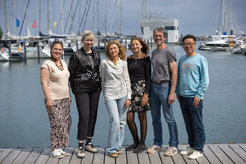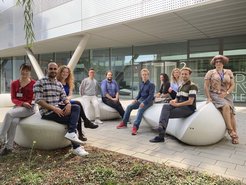Catalysis with Metals
Groupleader: Katarzyna Skorupska

We focus our research on the synthesis and characterization of novel metal film catalysts that challenge the so far utilized and mostly studied powder catalysts for the use in renewable energy. We aim at tuning catalyst properties by varying the synthesis and activation conditions, in particular, to comparatively study the steps of the growth of catalyst morphologies for thin film and powder systems. We compare the performance of the discrete systems under thermal heterogenous reactions with C-H, C-O activation, for instance under reverse water-gas-shift (rWGS) reaction and acetylene hydrogenation.
Coking of metal catalyst during a number of catalytical reactions, amongst them propane dehydrogenation, leads to its deactivation. Therefore, our group has also studied low temperature regeneration of coked Pt catalysts.
Metal catalytic materials are important because they easily donate or accept electrons in reduction and oxidation catalytical reactions adopting different oxidation states depending on the reaction environment. A suitable support can introduce synergistic effects that influence the morphology and catalyst shape as well as local electronic structure that may enhance catalytic activity. Formation of a functional interface is expected to influence the stability and to have a crucial effect on the population specificity of active centers created under reaction conditions. An additional strategy to tune the electronic properties and hence the catalytic activity can be achieved by incorporating a second metal into the catalytic system.
The new joint project of MPG and HZB, CatLab, specifies on the development and study of metal thin film catalyst systems as promising alternative to conventional powder catalysts. A major route consists in the shift from 3D structure, typical for powder materials, to 2D thin films eliminating unfavorable bulk influence and enhancing interface functionality.
A central task of the joint project of MPG and HZB Cat-Lab is to develop new types of catalysts to ensure efficient conversion of chemical energy into electrical energy and vice versa – the core of CatLab. The idea, in comparison with the standard powder catalysts, is to reduce the complexity of the catalyst structure by reducing the number of interfaces that can influence selectivity and performance of metal catalysts. The new route of catalyst design and synthesis is realized by reducing conventional three-dimensional catalyst materials to two dimensions. The thin films (< 10 nm) are deposited on a homogeneous support material by different vacuum deposition techniques and made available in collaboration with FHI Interface Science department and HZB partners. The aim is to tune the functional interphase using the strain introduced by the support into the metal catalyst by varying the surface properties of the substrate and the coverage of the metal catalyst film simultaneously. In consequence this leads to a control of the number of possible active adsorption sites via strong interaction of the substrate with the metal thin layer with the necessity that the landscape of active sites that forms during the contact of the catalyst with the reaction gas stays stable during the course of the reaction. The simplicity of such thin film 2D model systems will establish a firm base for theoretical simulations (in cooperation with FHI Theory department) leading to a better understanding of the catalytic processes and providing feedback to the synthesis groups.




